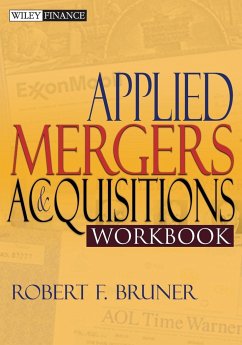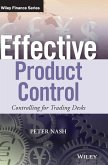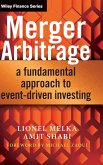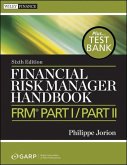Robert F. Bruner
Applied Mergers and Acquisitions Workbook
Robert F. Bruner
Applied Mergers and Acquisitions Workbook
- Broschiertes Buch
- Merkliste
- Auf die Merkliste
- Bewerten Bewerten
- Teilen
- Produkt teilen
- Produkterinnerung
- Produkterinnerung
The Applied Mergers and Acquisitions Workbook provides a useful self-training study guide for readers of Applied Mergers and Acquisitions who want to review the drivers of M&A success and failure. Useful review questions as well as problems and answers are provided for both professionals and students. Readers will further their knowledge, build practical intuition, and learn the art and science of M&A by using this comprehensive self-study workbook in conjunction with the main text.
Andere Kunden interessierten sich auch für
![Applied Mergers and Acquisitions, University Edition Applied Mergers and Acquisitions, University Edition]() Robert F. BrunerApplied Mergers and Acquisitions, University Edition83,99 €
Robert F. BrunerApplied Mergers and Acquisitions, University Edition83,99 €![Interest Rate Swaps Interest Rate Swaps]() Amir SadrInterest Rate Swaps72,99 €
Amir SadrInterest Rate Swaps72,99 €![Effective Product Control Effective Product Control]() Peter NashEffective Product Control101,99 €
Peter NashEffective Product Control101,99 €![Merger Arbitrage Merger Arbitrage]() Lionel MelkaMerger Arbitrage112,99 €
Lionel MelkaMerger Arbitrage112,99 €![Damodaran on Valuation Damodaran on Valuation]() Aswath DamodaranDamodaran on Valuation75,99 €
Aswath DamodaranDamodaran on Valuation75,99 €![Financial Risk Manager Handbook, + Test Bank Financial Risk Manager Handbook, + Test Bank]() Philippe JorionFinancial Risk Manager Handbook, + Test Bank161,99 €
Philippe JorionFinancial Risk Manager Handbook, + Test Bank161,99 €![Value Averaging Value Averaging]() Michael E. EdlesonValue Averaging21,99 €
Michael E. EdlesonValue Averaging21,99 €-
-
-
The Applied Mergers and Acquisitions Workbook provides a useful self-training study guide for readers of Applied Mergers and Acquisitions who want to review the drivers of M&A success and failure. Useful review questions as well as problems and answers are provided for both professionals and students. Readers will further their knowledge, build practical intuition, and learn the art and science of M&A by using this comprehensive self-study workbook in conjunction with the main text.
Produktdetails
- Produktdetails
- Wiley Finance Series
- Verlag: Wiley & Sons
- 1. Auflage
- Seitenzahl: 384
- Erscheinungstermin: 16. März 2004
- Englisch
- Abmessung: 254mm x 178mm x 21mm
- Gewicht: 678g
- ISBN-13: 9780471395850
- ISBN-10: 0471395854
- Artikelnr.: 14870413
- Herstellerkennzeichnung
- Libri GmbH
- Europaallee 1
- 36244 Bad Hersfeld
- gpsr@libri.de
- Wiley Finance Series
- Verlag: Wiley & Sons
- 1. Auflage
- Seitenzahl: 384
- Erscheinungstermin: 16. März 2004
- Englisch
- Abmessung: 254mm x 178mm x 21mm
- Gewicht: 678g
- ISBN-13: 9780471395850
- ISBN-10: 0471395854
- Artikelnr.: 14870413
- Herstellerkennzeichnung
- Libri GmbH
- Europaallee 1
- 36244 Bad Hersfeld
- gpsr@libri.de
ROBERT F. BRUNER is the Distinguished Professor of Business Administration at the Darden School of the University of Virginia and Executive Director of the Batten Institute. He directs the Darden School's executive education course on mergers and acquisitions, and teaches the popular MBA elective on that topic. He is the author of over 250 case studies and a casebook, Case Studies in Finance: Managing for Corporate Value Creation, which has been adopted for use at over 200 schools. Bruner's articles have been published in the Journal of Financial Economics, the Journal of Accounting and Economics, the Journal of Financial and Quantitative Analysis, the Journal of Money, Credit, and Banking, and Financial Management. He has served as a consultant to over twenty corporations as well as to the U.S. Government, and prior to his academic career, worked as a commercial banker and venture capitalist. Bruner holds a BA from Yale University, and an MBA and DBA from Harvard University.
Introduction to the Workbook.
PART ONE: QUESTIONS.
Chapter 1: Introduction and Executive Summary.
Chapter 2: Ethics in M&A.
Chapter 3: Does M&A Pay?
Chapter 4: M&A Activity.
Chapter 5: Cross-Border M&A.
Chapter 6: Strategy and the Uses of M&A to Grow or Restructure the Firm.
Chapter 7: Acquisition Search and Deal Origination: Some Guiding
Principles.
Chapter 8: Due Diligence.
Chapter 9: Valuing Firms.
Chapter 10: Valuing Options.
Chapter 11: Valuing Synergies.
Chapter 12: Valuing the Firm across Borders.
Chapter 13: Valuing the Highly Levered Firm, Assessing the Highly Levered
Transaction.
Chapter 14: Real Options and Their Impact on M&A.
Chapter 15: Valuing Liquidity and Control.
Chapter 16: Financial Accounting for Mergers and Acquisitions.
Chapter 17: Momentum Acquisition Strategies: An Illustration of Why Value
Creation Is the Best Financial Criterion.
Chapter 18: An Introduction to Deal Design in M&A.
Chapter 19: Choosing the Form of Acquisitive Reorganization.
Chapter 20: Choosing the Form of Payment and Financing.
Chapter 21: Framework for Structuring the Terms of Exchange: Finding the
"Win-Win" Deal.
Chapter 22: Structuring and Valuing Contingent Payments in M&A.
Chapter 23: Risk Management in M&A.
Chapter 24: Social Issues.
Chapter 25: How a Negotiated Deal Takes Shape.
Chapter 26: Governance in M&A: The Board of Directors and Shareholder
Voting.
Chapter 27: Rules of the Road: Securities Law, Issuance Process,
Disclosure, and Insider Trading.
Chapter 28: Rules of the Road: Antitrust Law.
Chapter 29: Documenting the M&A Deal.
Chapter 30: Negotiating the Deal.
Chapter 31: Auctions in M&A.
Chapter 32: Hostile Takeovers: Preparing a Bid in Light of Competition and
Arbitrage.
Chapter 33: Takeover Attack and Defense.
Chapter 34: The Leveraged Restructuring as a Takeover Defense: The Case of
American Standard.
Chapter 35: Communicating the Deal: Gaining Mandates, Approval, and
Support.
Chapter 36: Framework for Postmerger Integration.
Chapter 37: Corporate Development as a Strategic Capability: The Approach
of GE Power Systems.
Chapter 38: M&A "Best Practices": Some Lessons and Next Steps.
PART TWO: ANSWERS.
Chapter 1: Introduction and Executive Summary.
Chapter 2: Ethics in M&A.
Chapter 3: Does M&A Pay?
Chapter 4: M&A Activity.
Chapter 5: Cross-Border M&A.
Chapter 6: Strategy and the Uses of M&A to Grow or Restructure the Firm.
Chapter 7: Acquisition Search and Deal Origination: Some Guiding
Principles.
Chapter 8: Due Diligence.
Chapter 9: Valuing Firms.
Chapter 10: Valuing Options.
Chapter 11: Valuing Synergies.
Chapter 12: Valuing the Firm across Borders.
Chapter 13: Valuing the Highly Levered Firm, Assessing the Highly Levered
Transaction.
Chapter 14: Real Options and Their Impact on M&A.
Chapter 15: Valuing Liquidity and Control.
Chapter 16: Financial Accounting for Mergers and Acquisitions.
Chapter 17: Momentum Acquisition Strategies: An Illustration of Why Value
Creation Is the Best Financial Criterion.
Chapter 18: An Introduction to Deal Design in M&A.
Chapter 19: Choosing the Form of Acquisitive Reorganization.
Chapter 20: Choosing the Form of Payment and Financing.
Chapter 21: Framework for Structuring the Terms of Exchange: Finding the
"Win-Win" Deal.
Chapter 22: Structuring and Valuing Contingent Payments in M&A.
Chapter 23: Risk Management in M&A.
Chapter 24: Social Issues.
Chapter 25: How a Negotiated Deal Takes Shape.
Chapter 26: Governance in M&A: The Board of Directors and Shareholder
Voting.
Chapter 27: Rules of the Road: Securities Law, Issuance Process,
Disclosure, and Insider Trading.
Chapter 28: Rules of the Road: Antitrust Law.
Chapter 29: Documenting the M&A Deal.
Chapter 30: Negotiating the Deal.
Chapter 31: Auctions in M&A.
Chapter 32: Hostile Takeovers: Preparing a Bid in Light of Competition and
Arbitrage.
Chapter 33: Takeover Attack and Defense.
Chapter 34: The Leveraged Restructuring as a Takeover Defense: The Case of
American Standard.
Chapter 35: Communicating the Deal: Gaining Mandates, Approval, and
Support.
Chapter 36: Framework for Postmerger Integration.
Chapter 37: Corporate Development as a Strategic Capability: The Approach
of GE Power Systems.
Chapter 38: M&A "Best Practices": Some Lessons and Next Steps.
PART ONE: QUESTIONS.
Chapter 1: Introduction and Executive Summary.
Chapter 2: Ethics in M&A.
Chapter 3: Does M&A Pay?
Chapter 4: M&A Activity.
Chapter 5: Cross-Border M&A.
Chapter 6: Strategy and the Uses of M&A to Grow or Restructure the Firm.
Chapter 7: Acquisition Search and Deal Origination: Some Guiding
Principles.
Chapter 8: Due Diligence.
Chapter 9: Valuing Firms.
Chapter 10: Valuing Options.
Chapter 11: Valuing Synergies.
Chapter 12: Valuing the Firm across Borders.
Chapter 13: Valuing the Highly Levered Firm, Assessing the Highly Levered
Transaction.
Chapter 14: Real Options and Their Impact on M&A.
Chapter 15: Valuing Liquidity and Control.
Chapter 16: Financial Accounting for Mergers and Acquisitions.
Chapter 17: Momentum Acquisition Strategies: An Illustration of Why Value
Creation Is the Best Financial Criterion.
Chapter 18: An Introduction to Deal Design in M&A.
Chapter 19: Choosing the Form of Acquisitive Reorganization.
Chapter 20: Choosing the Form of Payment and Financing.
Chapter 21: Framework for Structuring the Terms of Exchange: Finding the
"Win-Win" Deal.
Chapter 22: Structuring and Valuing Contingent Payments in M&A.
Chapter 23: Risk Management in M&A.
Chapter 24: Social Issues.
Chapter 25: How a Negotiated Deal Takes Shape.
Chapter 26: Governance in M&A: The Board of Directors and Shareholder
Voting.
Chapter 27: Rules of the Road: Securities Law, Issuance Process,
Disclosure, and Insider Trading.
Chapter 28: Rules of the Road: Antitrust Law.
Chapter 29: Documenting the M&A Deal.
Chapter 30: Negotiating the Deal.
Chapter 31: Auctions in M&A.
Chapter 32: Hostile Takeovers: Preparing a Bid in Light of Competition and
Arbitrage.
Chapter 33: Takeover Attack and Defense.
Chapter 34: The Leveraged Restructuring as a Takeover Defense: The Case of
American Standard.
Chapter 35: Communicating the Deal: Gaining Mandates, Approval, and
Support.
Chapter 36: Framework for Postmerger Integration.
Chapter 37: Corporate Development as a Strategic Capability: The Approach
of GE Power Systems.
Chapter 38: M&A "Best Practices": Some Lessons and Next Steps.
PART TWO: ANSWERS.
Chapter 1: Introduction and Executive Summary.
Chapter 2: Ethics in M&A.
Chapter 3: Does M&A Pay?
Chapter 4: M&A Activity.
Chapter 5: Cross-Border M&A.
Chapter 6: Strategy and the Uses of M&A to Grow or Restructure the Firm.
Chapter 7: Acquisition Search and Deal Origination: Some Guiding
Principles.
Chapter 8: Due Diligence.
Chapter 9: Valuing Firms.
Chapter 10: Valuing Options.
Chapter 11: Valuing Synergies.
Chapter 12: Valuing the Firm across Borders.
Chapter 13: Valuing the Highly Levered Firm, Assessing the Highly Levered
Transaction.
Chapter 14: Real Options and Their Impact on M&A.
Chapter 15: Valuing Liquidity and Control.
Chapter 16: Financial Accounting for Mergers and Acquisitions.
Chapter 17: Momentum Acquisition Strategies: An Illustration of Why Value
Creation Is the Best Financial Criterion.
Chapter 18: An Introduction to Deal Design in M&A.
Chapter 19: Choosing the Form of Acquisitive Reorganization.
Chapter 20: Choosing the Form of Payment and Financing.
Chapter 21: Framework for Structuring the Terms of Exchange: Finding the
"Win-Win" Deal.
Chapter 22: Structuring and Valuing Contingent Payments in M&A.
Chapter 23: Risk Management in M&A.
Chapter 24: Social Issues.
Chapter 25: How a Negotiated Deal Takes Shape.
Chapter 26: Governance in M&A: The Board of Directors and Shareholder
Voting.
Chapter 27: Rules of the Road: Securities Law, Issuance Process,
Disclosure, and Insider Trading.
Chapter 28: Rules of the Road: Antitrust Law.
Chapter 29: Documenting the M&A Deal.
Chapter 30: Negotiating the Deal.
Chapter 31: Auctions in M&A.
Chapter 32: Hostile Takeovers: Preparing a Bid in Light of Competition and
Arbitrage.
Chapter 33: Takeover Attack and Defense.
Chapter 34: The Leveraged Restructuring as a Takeover Defense: The Case of
American Standard.
Chapter 35: Communicating the Deal: Gaining Mandates, Approval, and
Support.
Chapter 36: Framework for Postmerger Integration.
Chapter 37: Corporate Development as a Strategic Capability: The Approach
of GE Power Systems.
Chapter 38: M&A "Best Practices": Some Lessons and Next Steps.
Introduction to the Workbook.
PART ONE: QUESTIONS.
Chapter 1: Introduction and Executive Summary.
Chapter 2: Ethics in M&A.
Chapter 3: Does M&A Pay?
Chapter 4: M&A Activity.
Chapter 5: Cross-Border M&A.
Chapter 6: Strategy and the Uses of M&A to Grow or Restructure the Firm.
Chapter 7: Acquisition Search and Deal Origination: Some Guiding
Principles.
Chapter 8: Due Diligence.
Chapter 9: Valuing Firms.
Chapter 10: Valuing Options.
Chapter 11: Valuing Synergies.
Chapter 12: Valuing the Firm across Borders.
Chapter 13: Valuing the Highly Levered Firm, Assessing the Highly Levered
Transaction.
Chapter 14: Real Options and Their Impact on M&A.
Chapter 15: Valuing Liquidity and Control.
Chapter 16: Financial Accounting for Mergers and Acquisitions.
Chapter 17: Momentum Acquisition Strategies: An Illustration of Why Value
Creation Is the Best Financial Criterion.
Chapter 18: An Introduction to Deal Design in M&A.
Chapter 19: Choosing the Form of Acquisitive Reorganization.
Chapter 20: Choosing the Form of Payment and Financing.
Chapter 21: Framework for Structuring the Terms of Exchange: Finding the
"Win-Win" Deal.
Chapter 22: Structuring and Valuing Contingent Payments in M&A.
Chapter 23: Risk Management in M&A.
Chapter 24: Social Issues.
Chapter 25: How a Negotiated Deal Takes Shape.
Chapter 26: Governance in M&A: The Board of Directors and Shareholder
Voting.
Chapter 27: Rules of the Road: Securities Law, Issuance Process,
Disclosure, and Insider Trading.
Chapter 28: Rules of the Road: Antitrust Law.
Chapter 29: Documenting the M&A Deal.
Chapter 30: Negotiating the Deal.
Chapter 31: Auctions in M&A.
Chapter 32: Hostile Takeovers: Preparing a Bid in Light of Competition and
Arbitrage.
Chapter 33: Takeover Attack and Defense.
Chapter 34: The Leveraged Restructuring as a Takeover Defense: The Case of
American Standard.
Chapter 35: Communicating the Deal: Gaining Mandates, Approval, and
Support.
Chapter 36: Framework for Postmerger Integration.
Chapter 37: Corporate Development as a Strategic Capability: The Approach
of GE Power Systems.
Chapter 38: M&A "Best Practices": Some Lessons and Next Steps.
PART TWO: ANSWERS.
Chapter 1: Introduction and Executive Summary.
Chapter 2: Ethics in M&A.
Chapter 3: Does M&A Pay?
Chapter 4: M&A Activity.
Chapter 5: Cross-Border M&A.
Chapter 6: Strategy and the Uses of M&A to Grow or Restructure the Firm.
Chapter 7: Acquisition Search and Deal Origination: Some Guiding
Principles.
Chapter 8: Due Diligence.
Chapter 9: Valuing Firms.
Chapter 10: Valuing Options.
Chapter 11: Valuing Synergies.
Chapter 12: Valuing the Firm across Borders.
Chapter 13: Valuing the Highly Levered Firm, Assessing the Highly Levered
Transaction.
Chapter 14: Real Options and Their Impact on M&A.
Chapter 15: Valuing Liquidity and Control.
Chapter 16: Financial Accounting for Mergers and Acquisitions.
Chapter 17: Momentum Acquisition Strategies: An Illustration of Why Value
Creation Is the Best Financial Criterion.
Chapter 18: An Introduction to Deal Design in M&A.
Chapter 19: Choosing the Form of Acquisitive Reorganization.
Chapter 20: Choosing the Form of Payment and Financing.
Chapter 21: Framework for Structuring the Terms of Exchange: Finding the
"Win-Win" Deal.
Chapter 22: Structuring and Valuing Contingent Payments in M&A.
Chapter 23: Risk Management in M&A.
Chapter 24: Social Issues.
Chapter 25: How a Negotiated Deal Takes Shape.
Chapter 26: Governance in M&A: The Board of Directors and Shareholder
Voting.
Chapter 27: Rules of the Road: Securities Law, Issuance Process,
Disclosure, and Insider Trading.
Chapter 28: Rules of the Road: Antitrust Law.
Chapter 29: Documenting the M&A Deal.
Chapter 30: Negotiating the Deal.
Chapter 31: Auctions in M&A.
Chapter 32: Hostile Takeovers: Preparing a Bid in Light of Competition and
Arbitrage.
Chapter 33: Takeover Attack and Defense.
Chapter 34: The Leveraged Restructuring as a Takeover Defense: The Case of
American Standard.
Chapter 35: Communicating the Deal: Gaining Mandates, Approval, and
Support.
Chapter 36: Framework for Postmerger Integration.
Chapter 37: Corporate Development as a Strategic Capability: The Approach
of GE Power Systems.
Chapter 38: M&A "Best Practices": Some Lessons and Next Steps.
PART ONE: QUESTIONS.
Chapter 1: Introduction and Executive Summary.
Chapter 2: Ethics in M&A.
Chapter 3: Does M&A Pay?
Chapter 4: M&A Activity.
Chapter 5: Cross-Border M&A.
Chapter 6: Strategy and the Uses of M&A to Grow or Restructure the Firm.
Chapter 7: Acquisition Search and Deal Origination: Some Guiding
Principles.
Chapter 8: Due Diligence.
Chapter 9: Valuing Firms.
Chapter 10: Valuing Options.
Chapter 11: Valuing Synergies.
Chapter 12: Valuing the Firm across Borders.
Chapter 13: Valuing the Highly Levered Firm, Assessing the Highly Levered
Transaction.
Chapter 14: Real Options and Their Impact on M&A.
Chapter 15: Valuing Liquidity and Control.
Chapter 16: Financial Accounting for Mergers and Acquisitions.
Chapter 17: Momentum Acquisition Strategies: An Illustration of Why Value
Creation Is the Best Financial Criterion.
Chapter 18: An Introduction to Deal Design in M&A.
Chapter 19: Choosing the Form of Acquisitive Reorganization.
Chapter 20: Choosing the Form of Payment and Financing.
Chapter 21: Framework for Structuring the Terms of Exchange: Finding the
"Win-Win" Deal.
Chapter 22: Structuring and Valuing Contingent Payments in M&A.
Chapter 23: Risk Management in M&A.
Chapter 24: Social Issues.
Chapter 25: How a Negotiated Deal Takes Shape.
Chapter 26: Governance in M&A: The Board of Directors and Shareholder
Voting.
Chapter 27: Rules of the Road: Securities Law, Issuance Process,
Disclosure, and Insider Trading.
Chapter 28: Rules of the Road: Antitrust Law.
Chapter 29: Documenting the M&A Deal.
Chapter 30: Negotiating the Deal.
Chapter 31: Auctions in M&A.
Chapter 32: Hostile Takeovers: Preparing a Bid in Light of Competition and
Arbitrage.
Chapter 33: Takeover Attack and Defense.
Chapter 34: The Leveraged Restructuring as a Takeover Defense: The Case of
American Standard.
Chapter 35: Communicating the Deal: Gaining Mandates, Approval, and
Support.
Chapter 36: Framework for Postmerger Integration.
Chapter 37: Corporate Development as a Strategic Capability: The Approach
of GE Power Systems.
Chapter 38: M&A "Best Practices": Some Lessons and Next Steps.
PART TWO: ANSWERS.
Chapter 1: Introduction and Executive Summary.
Chapter 2: Ethics in M&A.
Chapter 3: Does M&A Pay?
Chapter 4: M&A Activity.
Chapter 5: Cross-Border M&A.
Chapter 6: Strategy and the Uses of M&A to Grow or Restructure the Firm.
Chapter 7: Acquisition Search and Deal Origination: Some Guiding
Principles.
Chapter 8: Due Diligence.
Chapter 9: Valuing Firms.
Chapter 10: Valuing Options.
Chapter 11: Valuing Synergies.
Chapter 12: Valuing the Firm across Borders.
Chapter 13: Valuing the Highly Levered Firm, Assessing the Highly Levered
Transaction.
Chapter 14: Real Options and Their Impact on M&A.
Chapter 15: Valuing Liquidity and Control.
Chapter 16: Financial Accounting for Mergers and Acquisitions.
Chapter 17: Momentum Acquisition Strategies: An Illustration of Why Value
Creation Is the Best Financial Criterion.
Chapter 18: An Introduction to Deal Design in M&A.
Chapter 19: Choosing the Form of Acquisitive Reorganization.
Chapter 20: Choosing the Form of Payment and Financing.
Chapter 21: Framework for Structuring the Terms of Exchange: Finding the
"Win-Win" Deal.
Chapter 22: Structuring and Valuing Contingent Payments in M&A.
Chapter 23: Risk Management in M&A.
Chapter 24: Social Issues.
Chapter 25: How a Negotiated Deal Takes Shape.
Chapter 26: Governance in M&A: The Board of Directors and Shareholder
Voting.
Chapter 27: Rules of the Road: Securities Law, Issuance Process,
Disclosure, and Insider Trading.
Chapter 28: Rules of the Road: Antitrust Law.
Chapter 29: Documenting the M&A Deal.
Chapter 30: Negotiating the Deal.
Chapter 31: Auctions in M&A.
Chapter 32: Hostile Takeovers: Preparing a Bid in Light of Competition and
Arbitrage.
Chapter 33: Takeover Attack and Defense.
Chapter 34: The Leveraged Restructuring as a Takeover Defense: The Case of
American Standard.
Chapter 35: Communicating the Deal: Gaining Mandates, Approval, and
Support.
Chapter 36: Framework for Postmerger Integration.
Chapter 37: Corporate Development as a Strategic Capability: The Approach
of GE Power Systems.
Chapter 38: M&A "Best Practices": Some Lessons and Next Steps.









